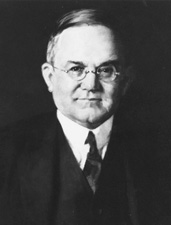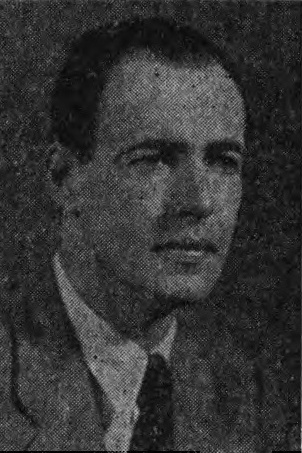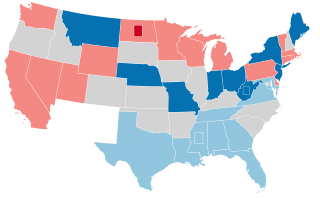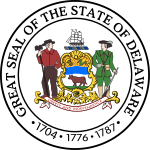
James Asheton Bayard Sr. was an American lawyer and politician from Wilmington, Delaware. He was a member of the Federalist Party, who served as U.S. Representative from Delaware and U.S. Senator from Delaware.

The 1978 United States Senate elections were held on November 7, in the middle of Democratic President Jimmy Carter's term. The 33 seats of Class 2 were contested in regular elections. Special elections were also held to fill vacancies. Thirteen seats changed hands between parties, resulting in a net gain of three seats for the Republicans. Democrats nevertheless retained a 58–41 majority.

The 1972 United States Senate elections were held on November 7, with the 33 seats of Class 2 contested in regular elections. They coincided with the landslide re-election of Republican President Richard Nixon. Despite Nixon's landslide victory, Democrats increased their majority by two seats. The Democrats picked up open seats in Kentucky and South Dakota, and defeated four incumbent senators: Gordon Allott of Colorado, J. Caleb Boggs of Delaware, Jack Miller of Iowa, and Margaret Chase Smith of Maine. The Republicans picked up open seats in New Mexico, North Carolina, and Oklahoma, and defeated one incumbent, William B. Spong Jr. of Virginia.

The 1964 United States Senate elections were held on November 3. The 33 seats of Class 1 were contested in regular elections. Special elections were also held to fill vacancies. They coincided with the election of President Lyndon B. Johnson by an overwhelming majority, to a full term. His Democratic Party picked up a net two seats from the Republicans. As of 2022, this was the last time either party has had a two-thirds majority in the Senate, which would have hypothetically allowed the Senate Democrats to override a veto, propose constitutional amendments, or convict and expel certain officials without any votes from Senate Republicans. In practice, however, internal divisions effectively prevented the Democrats from doing so. The Senate election coincided with Democratic gains in the House in the same year.

The 1958 United States Senate elections were elections for the United States Senate which occurred in the middle of President Dwight D. Eisenhower's second term. Thirty-two seats of Class 1 were contested in regular elections, the new state of Alaska held its first Senate elections for its Class 2 and 3 seats, and two special elections were held to fill vacancies.

Thomas Francis Bayard Jr. was an American lawyer and politician from Wilmington, Delaware. He was a Democratic U.S. Senator from Delaware in the 1920s.

John Gillis Townsend Jr. was an American businessman and politician from Selbyville in Sussex County, Delaware. He was a member of the Republican Party who served one term as Governor and two terms as U.S. Senator from Delaware.

James Miller Tunnell was an American lawyer and politician from Georgetown, in Sussex County, Delaware. He was a member of the Democratic Party, and served as U.S. Senator from Delaware.

James Hurd Hughes was an American lawyer and politician from Dover, in Kent County, Delaware. He was a member of the Democratic Party who served as U.S. Senator from Delaware.

Daniel Oren Hastings was an American lawyer and politician from Wilmington, New Castle County, Delaware. He was a member of the Republican Party who served two terms as a U.S. Senator from Delaware.

Alexis Irénée du Pont Bayard was an American lawyer and politician from Rockland, near Greenville, in New Castle County, Delaware. A member of the Democratic Party, he served as the 13th Lieutenant Governor of Delaware from 1949 to 1953 and ran unsuccessfully for the United States Senate in 1952.

The 1910–11 United States Senate election were held on various dates in various states. As these U.S. Senate elections were prior to the ratification of the Seventeenth Amendment in 1913, senators were primarily chosen by state legislatures. Senators were elected over a wide range of time throughout 1910 and 1911, and a seat may have been filled months late or remained vacant due to legislative deadlock. However, some states had already begun direct elections during this time. Oregon pioneered direct election and experimented with different measures over several years until it succeeded in 1907. Soon after, Nebraska followed suit and laid the foundation for other states to adopt measures reflecting the people's will. By 1912, as many as 29 states elected senators either as nominees of their party's primary or in conjunction with a general election.
The Delaware Democratic Party (DelDems) is the affiliate of the Democratic Party in the U.S. state of Delaware. It is headquartered in New Castle County and chaired by Erik Raser-Schramm.

The 1884 United States elections were held on November 4, electing the members of the 49th United States Congress. The election took place during the Third Party System. The Democratic Governor Grover Cleveland of New York defeated Republican Secretary of State James G. Blaine in the presidential election. In Congress, the Republicans retained control of the Senate while Democrats maintained control of the House of Representatives, therefore the Democrats failed to obtain a trifecta. This is the last time in which the Democratic President comes to office without unified control of Congress. In 2021, President Joe Biden was narrowly close to becoming the first Democratic President since Cleveland to take office without a trifecta.

The 2016 United States House of Representatives election in Delaware was held on November 8, 2016, to elect the U.S. representative from the state of Delaware from Delaware's at-large congressional district. The election coincided with the 2016 U.S. presidential election, as well as other elections to the House of Representatives, elections to the United States Senate and various state and local elections. The primaries were held on September 13.

The 1952 United States Senate election in Delaware took place on November 4, 1952. Incumbent Republican U.S. Senator John J. Williams was re-elected to a second term in office over Democratic Lieutenant Governor Alexis I. du Pont Bayard, the son of former Senator Thomas F. Bayard, Jr. and descendant of two of Delaware's most powerful families, the du Ponts and the Bayards.

The 1922 United States Senate election in Delaware took place on November 7, 1922. This election pitted Delaware's two most powerful families, the Republican du Ponts and the Democratic Bayards, against each other.

The 1940 United States Senate election in Delaware took place on November 5, 1940. Incumbent Republican U.S. Senator John G. Townsend Jr. ran for re-election to a third term in office, but was defeated by Democrat James M. Tunnell. This was the only seat that Democratic flipped during this cycle. This was the last time Democrats won Delaware's Class 1 Senate seat until Tom Carper's victory over Senator William Roth in 2000.

The 1934 United States Senate election in Delaware took place on November 6, 1934. Incumbent Republican U.S. Senator John G. Townsend Jr. was re-elected to a second term in office over Democratic U.S. Representative Wilbur L. Adams.

The 1916 Delaware gubernatorial election was held on November 7, 1916. Incumbent Republican Governor Charles R. Miller declined to run for re-election. At the time, the Republican Party was in the middle of a schism that had first developed during the 1912 presidential election. However, the schism did not affect the gubernatorial nomination; though there were rumors that the state party convention might seek to nominate Governor Miller for a second term, former State Representative John G. Townsend Jr. was seen as the frontrunner heading into the convention. He received the nomination without much difficulty and the Republican Party solidified around him its gubernatorial nominee. The Democratic Party nominated former Secretary of State James H. Hughes, and both Townsend and Hughes advanced to the general election.


















